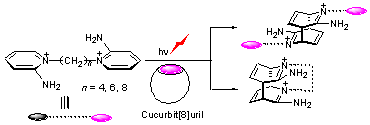[1] Freeman, W. A.; Mock, W. L.; Shih, N. Y. J. Am. Chem. Soc. 1981,103, 7367.

[2] Day, A. I.; Arnold, A. P.; Blanck, R. J. Molecules 2003, 8(1), 74.

[3] Lagona, J.; Mukhopadhyay, P.; Chakrabarti, S.; Isaacs, L. Angew.Chem., Int. Ed. 2005, 44(31), 4844.
[4] Yang, C.; Mori, T.; Origane, Y.; Ko, Y. H.; Selvapalam, N.; Kim,K.; Inoue, Y. J. Am. Chem. Soc. 2008, 130, 8574.

[5] Cong, H.; Zhu, Q. J.; Xue, S. F.; Tao, Z.; Wei, G. Chin. Sci. Bull.2010, 55(32), 3633.

[6] Montes-Navajas, P.; Corma, A.; Garcia, H. ChemPhysChem 2008,9, 713.

[7] Halterman, R. L.; Moore, J. L.; Mannel, L. M. J. Org. Chem. 2008,73, 3266.

[8] Saleh, N.; Koner, A. L.; Nau W. M. Angew. Chem., Int. Ed. 2008,47, 5398.

[9] Cong, H.; Li, C.-R.; Xue, S.-F.; Tao, Z.; Zhu, Q.-J.; Wei, G. Org.Biomol. Chem. 2011, 9, 1041.

[10] Zeng, J.-P.; Zhang, S.-M.; Zhang, Y.-Q.; Tao, Z.; Zhu, Q.-J.; Xue,S.-F.; Wei, G. Cryst. Growth Des. 2010, 10(10), 4509.

[11] Ni, X.-L.; Lin, J.-X.; Zheng, Y.-Y.; Wu, W.-S.; Zhang, Y.-Q.; Xue,S.-F.; Zhu, Q.-J.; Tao, Z.; Day, A. I. Cryst. Growth Des. 2008, 8(9),3446.

[12] Mock, W. L.; Shih, N. Y. J. Org. Chem. 1983, 48, 3618.

[13] Cong, H.; Tao, Z.; Xue, S. F. Zhu, Q.-J. Curr. Org. Chem. 2011,15, 86.

[14] Jon, S. Y.; Ko, Y. H.; Park, S. H.; Kim, H. J.; Kim, K. Chem.Commun. 2001, 1938.

[15] Lei, L.; Luo, L.; Wu, X.-L.; Liao, G.-H.; Wu, L.-Z.; Tung C.-H.Tetrahedron Lett. 2008, 49, 1502.

[16] Barooah, N.; Pemberton, B. C.; Johnson A. C.; Sivaguru, J. Photochem.Photobiol. Sci. 2008, 7, 1473.

[17] Barooah, N.; Pemberton, B. C.; Sivaguru, J. Org. Lett. 2008,10(15), 3339.

[18] Lei, L.; Luo, L.; Wu, X.-L.; Liao, G.-H.; Wu, L.-Z.; Tung C.-H.Tetrahedron Lett. 2008, 49, 1502.

[19] Wang, R. B.; Yuan, L.; Macartney, D. H. J. Org. Chem. 2006, 71,1237.

[20] Wang, Q. -S.; Cong, H.; Zhang, J.-X.; Tao, Z.; Xue. S.-F. Chin. J.Org. Chem. 2011, 31(7), 1049 (in Chinese).(王杞生, 丛航, 张建新, 陶朱, 薛赛凤, 有机化学, 2011, 31(7),1049.)

[21] Wu, X.-L.; Luo, L.; Lei, L.; Liao, G.-H.; Wu, L.-Z.; Tung C.-H. J.Org. Chem. 2008, 73, 491.























